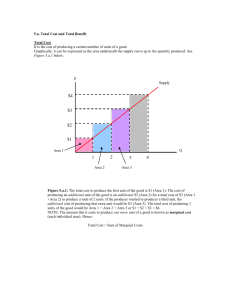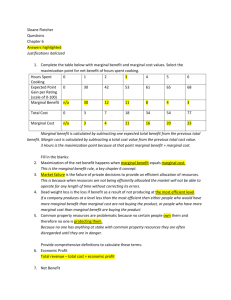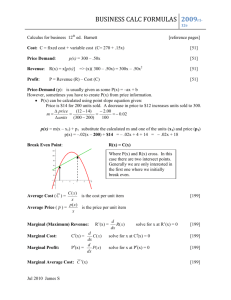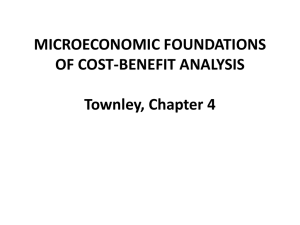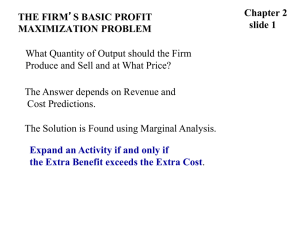Questions
advertisement
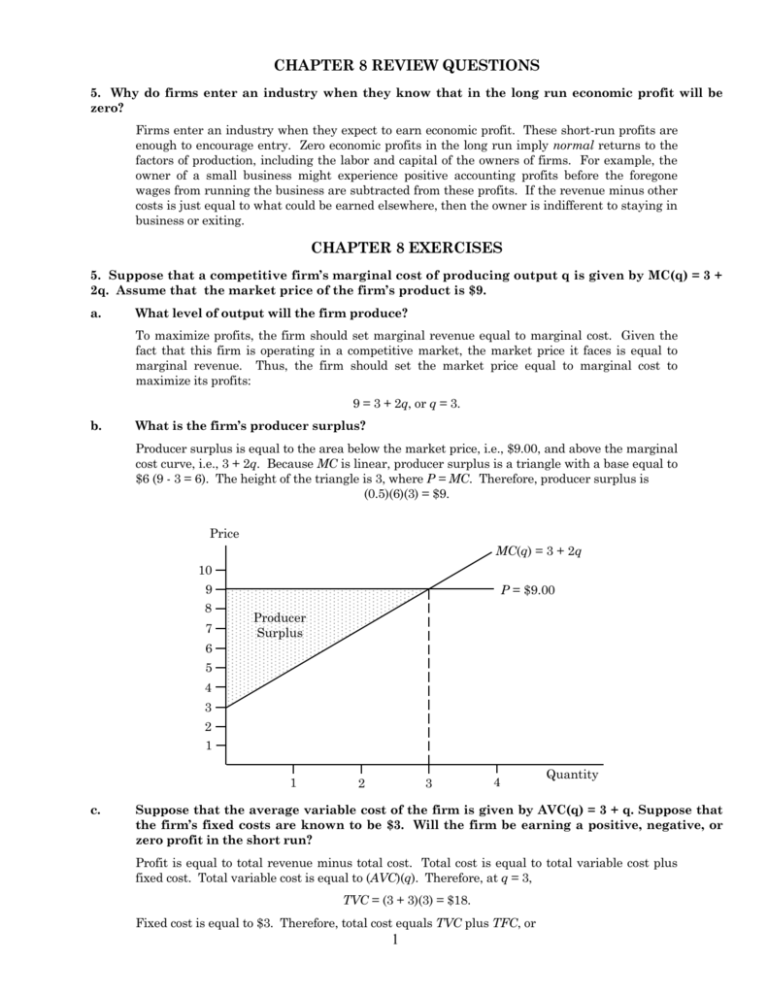
CHAPTER 8 REVIEW QUESTIONS 5. Why do firms enter an industry when they know that in the long run economic profit will be zero? Firms enter an industry when they expect to earn economic profit. These short-run profits are enough to encourage entry. Zero economic profits in the long run imply normal returns to the factors of production, including the labor and capital of the owners of firms. For example, the owner of a small business might experience positive accounting profits before the foregone wages from running the business are subtracted from these profits. If the revenue minus other costs is just equal to what could be earned elsewhere, then the owner is indifferent to staying in business or exiting. CHAPTER 8 EXERCISES 5. Suppose that a competitive firm’s marginal cost of producing output q is given by MC(q) = 3 + 2q. Assume that the market price of the firm’s product is $9. a. What level of output will the firm produce? To maximize profits, the firm should set marginal revenue equal to marginal cost. Given the fact that this firm is operating in a competitive market, the market price it faces is equal to marginal revenue. Thus, the firm should set the market price equal to marginal cost to maximize its profits: 9 = 3 + 2q, or q = 3. b. What is the firm’s producer surplus? Producer surplus is equal to the area below the market price, i.e., $9.00, and above the marginal cost curve, i.e., 3 + 2q. Because MC is linear, producer surplus is a triangle with a base equal to $6 (9 - 3 = 6). The height of the triangle is 3, where P = MC. Therefore, producer surplus is (0.5)(6)(3) = $9. Price MC(q) = 3 + 2q 10 9 8 7 6 P = $9.00 Producer Producer’s Surplus Surplus 5 4 3 2 1 1 c. 2 3 4 Quantity Suppose that the average variable cost of the firm is given by AVC(q) = 3 + q. Suppose that the firm’s fixed costs are known to be $3. Will the firm be earning a positive, negative, or zero profit in the short run? Profit is equal to total revenue minus total cost. Total cost is equal to total variable cost plus fixed cost. Total variable cost is equal to (AVC)(q). Therefore, at q = 3, TVC = (3 + 3)(3) = $18. Fixed cost is equal to $3. Therefore, total cost equals TVC plus TFC, or 1 TC = 18 + 3 = $21. Total revenue is price times quantity: TR = ($9)(3) = $27. Profit is total revenue minus total cost: = $27 - $21 = $6. Therefore, the firm is earning positive economic profits. More easily, you might recall that profit equals producer surplus minus fixed cost. Since we found that producer surplus was $9 in part b, profit equals 9-3 or $6. 6. A firm produces a product in a competitive industry and has a total cost function TC 50 4q 2q 2 and a marginal cost function MC 4 4q. At the given market price of $20, the firm is producing 5 units of output. Is the firm maximizing profit? What quantity of output should the firm produce in the long run? If the firm is maximizing profit, then price will be equal to marginal cost. P=MC results in P=20=4+4q=MC, or q=4. The firm is not maximizing profit, since it is producing too much output. The current level of profit is profit = 20*5-(50+4*5+2*5*5) = –20, and the profit maximizing level is profit = 20*4-(50+4*4+2*4*4) = –18. Given no change in the price of the product or the cost structure of the firm, the firm should produce q=0 units of output in the long run since at the quantity where price is equal to marginal cost, economic profit is negative. The firm should exit the industry. 1 9. a. Suppose that a firm’s production function is q 9x 2 in the short run, where there are fixed costs of $1,000 and x is the variable input, whose cost is $4,000 per unit. What is the total cost of producing a level of output q. In other words, identify the total cost function C(q). The total cost function C(x) = fixed cost + variable cost = 1000 + 4000x. Since the variable input costs $4,000 per unit, the variable cost is 4000 times the number of units, or 4000x. Now rewrite the production function to express x in terms of q so that substitute this into the above cost function to find C(q): C(q) b. x q2 . We can then 81 4000q2 1000 . 81 Write down the equation for the supply curve. The firm supplies output where P=MC so the marginal cost curve is the supply curve, or P c. 8000q . 81 If price is $1000, how many units will the firm produce? What is the level of profit? Illustrate on a cost curve graph. To figure this out, set price equal to marginal cost to find: P 8000q 1000 q 10.125 . 81 Profit is 1000*10.125-(1000+(4000*10.125*10.125)/81) = 4062.5. Graphically, the firm produces where the price line hits the MC curve. Since profit is positive, this will occur at a quantity where price is greater than average cost. To find profit on the graph, take the difference of the revenue box (price times quantity) and the cost box (average cost times quantity). This rectangle is the profit area. 2

